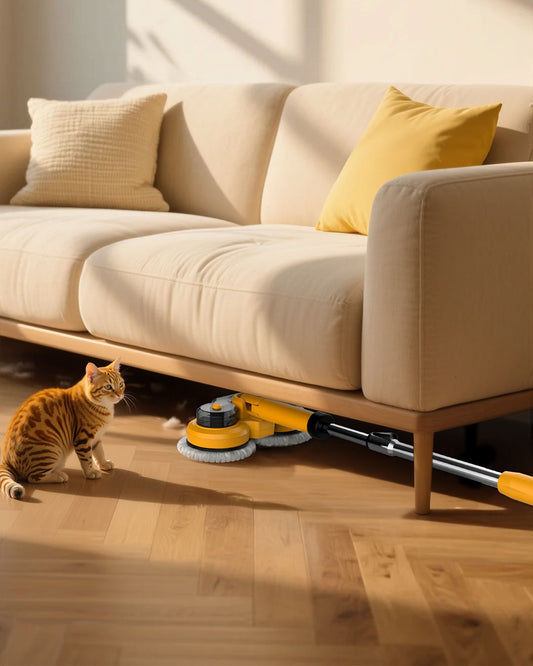Electric Mop vs Traditional Mop: Which One Saves More Time?
Keeping a home clean is never an easy task, especially when you're juggling work, family, and pets. While mopping might seem like a simple chore, it often consumes a significant amount of time and physical effort. So, the real question is: are electric mops actually more time-efficient than traditional ones?
This article will compare the two from three key perspectives: cleaning efficiency, user experience, and overall results, helping you find the cleaning tool that’s right for you.
Why Cleaning Efficiency Matters for Busy Homes
For most families today, time is a scarce resource. Spending 30 minutes scrubbing the kitchen floor with a traditional mop may feel manageable at first, but when you add living room tiles, bathroom stains, and pet messes, it quickly becomes overwhelming.
Electric Mop: Features and Advantages
What is an Electric Mop?
An electric mop uses a motorized dual-head system to rotate cleaning pads at high speed, removing stains with minimal effort. Unlike traditional mops that rely on hand pressure, electric mops deliver consistent scrubbing power.
How Qimedo M1 Electric Mop Works
The Qimedo M1 Electric Mop is designed with three adjustable speeds (400 / 600 / 800 RPM), a 300ml spray water tank, and a dual-battery system for up to 211 minutes runtime.
Benefits for Families with Pets and Large Homes
- Faster Cleaning: Covers large areas in less time.
- Effortless Operation: Minimal bending, suitable for elderly or pregnant users.
- Deeper Hygiene: High-speed scrubbing removes sticky stains and pet mess.
Traditional Mop: Strengths and Limitations
When a Traditional Mop Still Works Best
A traditional mop remains useful for small spaces, quick touch-ups, and budget-conscious households.
Why Manual Cleaning Takes More Time and Effort
However, traditional mops rely entirely on manual scrubbing, frequent rinsing, and bending down. This not only consumes more time but can also strain your back and knees over repeated use.
Side-by-Side Comparison

👉 According to internal Qimedo tests, the M1 Electric Mop cleans a 100㎡ apartment in 15 minutes, while a traditional mop may take 30 minutes or more.
Cost and Longevity
The True Cost of an Electric Mop
Although electric mops cost more upfront, features like replaceable batteries and durable pads make them a long-term value.
Why It’s a Smarter Investment
- Longer Lifespan: Outlasts multiple traditional mop sets.
- Lower Hidden Costs: Less detergent and fewer replacements needed.
- Saves Energy and Time: Reduces strain, improves sustainability.
Real-Life Evidence
One Qimedo M1 can replace four traditional mops in three years, cutting costs and waste.
Expert Tips for Faster Floor Cleaning
How to Maximize Electric Mop Efficiency
- Use the spray tank with clean water or mild detergent.
- Adjust speed: low for dust, high for sticky stains.
- Wash and replace pads regularly.
Mistakes to Avoid with Traditional Mops
- Using too much water → damages wooden floors.
- Not changing dirty water → spreads bacteria.
- Skipping maintenance → damp mop breeds mold.
Quick Hacks for Easier Floor Cleaning
- Vacuum before mopping to remove hair/dust.
- Pre-spray stubborn spots with warm water.
- Clean high-traffic areas more often.
Conclusion
So, which mop saves more time? The answer is clear: electric mops significantly reduce cleaning time, effort, and stress while delivering better hygiene results.
While traditional mops may still work for small jobs, families with pets, large homes, or busy schedules will benefit most from the convenience of an electric mop.
👉 Ready to save time and energy? Discover the Qimedo M1 Electric Mop and make cleaning effortless.




